A few years ago, when I was completing my Integral Coaching®️ certification, my amazing teacher made a joke about how flat and nonexistent her bottom was. She thought it was such a mystery because of all the glute exercises she regularly did and proceeded to list them off— clamshells, doggie-on-a-fire-hydrant, glute squeezes, squats, leg lifts, etc.
Everyone in the class laughed out loud, thinking it was hilarious, but I had to sit on my hands to stop myself from speaking out to solve her missing-booty mystery.
I felt like such a movement nerd, but I really had to hold back from explaining to the whole class why her butt was staying so flat and how simple her solution was.
And the answer was NOT a million squats or butt squeezes!
Your glutes are supposed to help you stand and walk, and when they don’t get to do this ever-important job, they turn off and droop.
So what IS causing this glute droop? What’s triggering your glutes to essentially shut down?
The short answer is wearing shoes with any heel elevation at all and sitting. But not just high heels, which my instructor always wore, but ANY shoe with a higher heel than your toes.
Combine that with lots of sitting in a chair all day and you have a perfect recipe for unhappy glutes.
If you wear standard shoes and sit down frequently, your glutes have probably adapted to being a modern human and might not be carrying their walking workload.
And when your glutes stop helping you stand and walk, other parts of your body have to kick in to keep you upright and moving forward. The human body’s ability to adapt is really pretty amazing that way!
But, don’t worry, if your body has adapted to wearing heeled shoes and sitting, and your bottom has gone inactive and flat, I’ve got great news for you.
As long as you’re alive, your body can change.
The cells of your body literally regenerate and adapt to help you become more efficient at what you spend the most time doing.
So, if you sit a lot and wear regular shoes, you just have to change the message you’re sending your cells by changing the way you use your body.
Today’s video shows you specific exercises and info so you can turn those glutes on and tone them up!
To send a turned-on and toned-up glute message, you need three main things:
- Information – The more you know about what’s happening in your body with walking, the easier it is to create change. Knowledge is pretty darn motivating (and exciting)!
- Corrective Exercises – There are specific exercises that will make all the difference in the world with strengthening and building endurance in your glutes.
- Move More – More specifically, walk more often and more frequently throughout your day. And the exercises in this video will help you walk better, so you get more out of walking and standing!
It might sound silly and dramatic, but learning how to activate and strengthen my glutes is one of the most empowering things I’ve ever done for my body.
Functional glute strength sets off a domino effect of positive changes. I’m talking about healthier:
- Lower back
- Spine
- Pelvic floor
- Knees
- Ankles
- Hips
In turn, this leads to more comfort and ease in your body, not to mention the ability to walk and run farther and faster!
Lol, I’m not gonna lie, though; one of the most satisfying and motivating side effects for me when it comes to well-functioning glutes is, hands down, the more lifted and rounded shape of my rear end. Flabby booty begone!
Today’s video is longer than my typical blog post, but that’s because I originally made it for the Pilates Tonic Online membership site. Have you checked it out yet?
I decided this information is so important I had to share it on the blog, too.
You’ll learn 5 corrective exercises to help get you walking better and lifting your derriere!
I’ve often regretted not speaking up that day in my Integral Coaching®️ class. Who knows, maybe I’ll send my teacher a link to this post (😆). But, I’m over the moon with excitement to share this information with you!
If you have any questions or comments, leave them below. I’d love to hear from you!
With love and lifted glutes,
Sydney

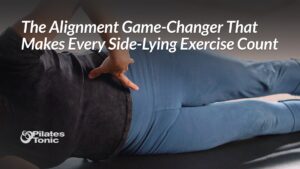
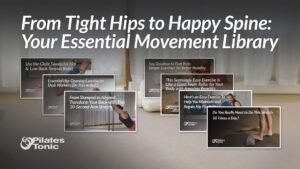
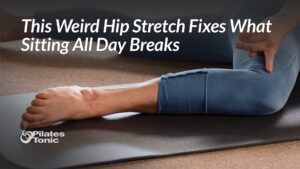
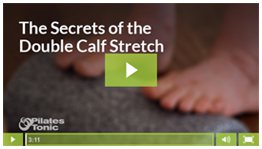

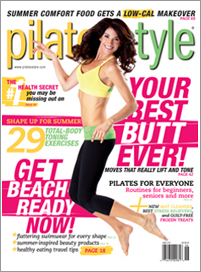
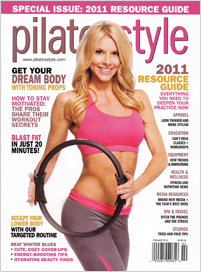
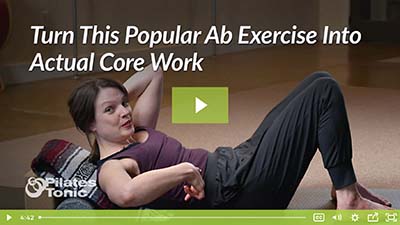
18 Responses
This was so very nice and informative. I walk almost everyday and love having this to improve my gait. Thank you for this Sydney. Glad to see you’re well.
Hi Amy, thanks for checking it out and so glad it was helpful! Hoping you’re well too!
These exercises are helpful, Sydney~thank you! Why, if a hip replacement, should someone not lower hip while performing hip list on a yoga block?
Hi Joy, A hip that’s been replaced doesn’t have the same range of motion as a natural hip, so I prefer to err on the side of caution by avoiding the full eccentric contraction in the Pelvic List on the yoga block. Thanks for your great question and feedback!
Thanks for sharing your knowledge. i have droopy bum yet hike 30km most days so must be using my quads mainly. Would it help to squeeze gluts when walking during the back position of leg? also, when you say move pubic bone forward are you also tucking the pelvis? Thanks so much
Hi Judy, Great questions! The goal is for the glutes to activate on their own without needing to add a glute squeeze. Practicing the corrective exercises in this video will help with that over time. From what you describe, the hip-flexor stretch could be especially beneficial and you might like to practice it more frequently. In the hip-flexor stretch, bringing your pubic bone forward will feel like tucking, but it actually just keeps your pelvis in neutral for this particular exercise. Hope this helps! Thanks for your questions!
Thank you so much for this video Sydney! You were so thorough in explaining what these positions should feel and look like and what that shouldn’t. I feel like I can actually practice these correctly without being supervised. Thanks again!
Hi Tiquisia, Thank you for your feedback and I’m so glad this video was helpful! It’s great to hear from you!
Hi Sydney, very informative videos, thank you, so should we be wearing completely flat shoes, nothing with a joy tiny platform or arch support? I have chronic plantar fascia in my one heel and can’t shift it, I was ok doing Myofascial Delaware stretches but they are no longer working? Any advice? Thank you
I’m a big fan of minimal shoes without heels or arch support. But, most people’s feet have adapted to wearing modern shoes, so it’s essential to prepare your body and feet first before switching to minimal shoes. The exercises in the post linked below are some exercises to help prepare the feet for more minimal footwear.
https://pilatestonic.com/2015/3-ways-your-shoes-messed-up-your-alignment-and-how-to-repair-it/
Northwest Foot & Ankle is a fantastic resource as well.
https://www.nwfootankle.com/
Hope this helps and thanks for your questions!
Thank you so much 💓
So glad this was helpful, Laura. Thanks for letting me know!
amazing series, thank you so much
So happy this was helpful, Evelien! Thanks for letting me know!
Awesome! Thank you! How I just magically found “These Glutes are Made For Walking”? Looked online for a glutes/hips best walking advice after a coincidental chat with a pilates former trainer at Costco! I am bookmarking your site and hope to join once my move to San Diego area is org’d. I walk 5-6 mi a day, when not playing tennis so this is perf!
Thanks for sharing, CC! I’m glad this was helpful. Best wishes on your move and I’d love to see you in Pilates Tonic Online when the time is right!
I started up brisk walking after a long hiatus due to back issues stopping me from my high impact workouts. I randomly looked up tightening glutes while walking as I felt doing so was helping me walk with more control. One video said glutes didn’t work while working, from an MD! I like your advice MUCH better. Made sense. Glad I found this, thank you and keeping shining bright!
So glad this was helpful, Teri! Thank you for letting me know!